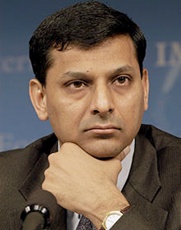RBI cuts repo rate by 25 bps to a 5-year low of 6.5%
05 Apr 2016
 In a widely anticipated move, Reserve Bank of India (RBI) today announced a 25 basis point reduction its repo rate, bringing the policy rate under the liquidity adjustment facility (LAF) from 6.75 per cent to 6.5 per cent, the lowest level since January 2011.
In a widely anticipated move, Reserve Bank of India (RBI) today announced a 25 basis point reduction its repo rate, bringing the policy rate under the liquidity adjustment facility (LAF) from 6.75 per cent to 6.5 per cent, the lowest level since January 2011.
The central bank also reduced the minimum daily cash reserve ratio (CRR) requirements of scheduled banks from 95 per cent of the requirement to 90 per cent with effect from the fortnight beginning 16 April 2016.
RBI, however, kept the cash reserve ratio (CRR) unchanged at 4.0 per cent of net demand and time liabilities (NDTL).
RBI said it would continue to provide liquidity as required and progressively lower the average ex-ante liquidity deficit in the system from one per cent of NDTL to a position closer to neutrality and narrow the policy rate corridor from (+/-)100 basis points to (+/-) 50 bps by reducing the MSF rate by 75 basis points and increasing the reverse repo rate by 25 basis points. This would ensure a finer alignment of the weighted average call rate with the repo rate, RBI said.
The reverse repo rate under the LAF also now stands adjusted to 6.0 per cent, and the marginal standing facility (MSF) rate to 7.0 per cent. The Bank Rate, which is aligned to the MSF rate also stands adjusted to 7.0 per cent.
The RBI had cut its repo rate by 125 basis points last year, and the latest reduction has been backed by a slowing of inflation to 5.18 per cent in February and the government keeping its borrowing and spending levels in the 2016-17 budget in check.
Banks, however, have only lowered their lending rates by around 60 bps so far, preventing a wider diffusion of the benefits of RBI's rate cuts.
RBI said the move has been guided more by a continued slackness in the domestic economy and the perceptions of downside risks to recovery in some advanced economies at the beginning of 2016, which have since eased, while major emerging market economies continue to contend with weak growth and still elevated inflation amidst tighter financial conditions.
RBI noted that gross value added (GVA) in agriculture and allied activities moderated in H2 of 2015-16, pulled down by the contraction in Q3 due to the year-on-year decline in kharif production.
The second advance estimates for Q4 indicate that rabi foodgrain production increased over its level a year ago – mainly in wheat and pulses – and compensated partly for the shortfall in kharif output.
Industrial activity accelerated in H2, led by manufacturing which benefited from the sustained softness in input costs. By contrast, industrial production remained flat with manufacturing output shrinking since November.
Robust expansion in coal output has buoyed both mining activity and electricity generation and stemmed the weakening of industrial output. However, capital goods production fell into deep contraction since November, even after excluding lumpy and volatile items like rubber insulated cable.
Weak demand and competition from imports have muted the capex cycle. Consumer non-durables production has been shrinking, with a pronounced decline in Q4. This reflects the continuing slack in rural demand.
On the other hand, consumer durables remained strong, even after abstracting from favourable base effects, which suggests that urban demand is holding up. With improved perceptions on overall economic conditions and income, the Reserve Bank's Consumer Confidence Survey of March 2016 shows marginal improvement in consumer sentiments.
The March manufacturing purchasing managers' index (PMI) continued in expansionary mode on the back of new orders, including exports. The Reserve Bank's industrial outlook survey suggests that business expectations for Q1 of 2016-17 continue to be positive.
Services sector activity expanded steadily through the year, with trade, hotels, transport, communication and public administration, defence and related services turning out to be the main drivers in H2.
The construction sector, however, continues to be overburdened by unsold inventory in the residential space, although commercial real estate is being boosted by demand from information technology (IT) and IT-enabled services. Road construction has accelerated, including in terms of new awards.
Cement production appears to have gained traction during H2, while steel consumption has increased at a steady pace. Various lead and coincident indicators such as air passenger traffic, air cargo volumes, foreign tourist arrivals and auto sales increased, while railway freight traffic marginally contracted. The services PMI remained in expansion mode during H2 on new business and expectations. The outlook for services in surveys is upbeat for Q1 of 2016-17.
Retail inflation measured by the consumer price index (CPI) dropped sharply in February after rising for six consecutive months.
Liquidity conditions, which had tightened since mid-December, were stretched further by the larger-than-usual accumulation of cash balances by the government, unusually heightened and persistent demand for currency, a pick-up in bank credit and flatter deposit mobilisation at this time relative to past years.
The Reserve Bank undertook liquidity operations to quell these pressures and supplemented normal operations with large amounts of liquidity injected through fine-tuning variable rate repo auctions in tenors ranging between overnight and 56 days.
India's international trade remained subdued due to falling import demand from emerging markets and stress in mining and extractive industries. In the US, consumer spending was underpinned by a strengthening labour market, but flagging exports proved to be a drag on growth in Q4 and cloud the near term outlook.






























